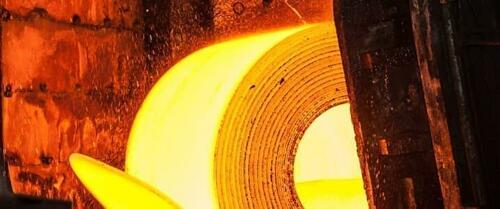
By Ag Metal Miner, published in OilPrice.com
A few days ago, China’s State Council announced more stimulus policies. The new measures included an additional 300 billion yuan ($44 billion) in quotas for infrastructure spending and investments by banks. This was in addition to the 300 billion yuan announced at June-end. However, the only real question regarding the stimuli is looking at everything happening with steel and iron ore prices: will it help? Most initial reports suggest that the move may give impetus to steel and iron ore off-take, both of which are in a months-long slump. However, other reports believe these new stimulus actions might not achieve their goals. More specifically, they won’t generate a renewed interest in construction activity in China. As a result, there won’t be much (if any) of a positive impact on the steel sector.
In 2021, China produced 1.033 billion tons of crude steel. It was the first decline since 2016. Thus far, in 2022, national steel production is down 6.4% year-on-year. The China Metallurgical Industry Planning and Research Institute predicted this at the beginning of the year, stating that China’s 2022 output would slow to 1.017 billion tons. This represents a 1.5% decrease from the year before.
Steel and Iron Ore Prices Bouncing Back
Following the recent stimuli announcement, a Bloomberg report stated that China’s raw materials prices, including iron ore prices, had officially steadied. This came after factory activity shrank less than expected in August. Meanwhile, the purchasing managers’ index for steel stayed in contraction, and the pace of its decline narrowed sharply.
Steel industry experts are hopeful that steel output will increase in September as the country starts to respond to the government stimulus efforts, which will hopefully aid iron ore prices. Some Chinese steel mills have already signaled that production is rising and profit margins are back in positive territory.
Indeed, thanks to the June and September stimuli packages, iron ore prices and some steel products are rebounding. For instance, Shanghai steel rebar initiated a recovery recovering its lowest close this year, moving from 3,704 yuan ($539) a ton on July 15 to 4,078 yuan on Aug. 26. Profit margins at steel mills, which were negative in July, returned to positive territory as well. S&P Global Commodity Insights reported a profit of about $50 a ton on rebar in August.
Rebar Also Struggling
Rebar inventories have also dropped. This is also a sign of activity picking up. After all, inventories had gone down in the last nine weeks. They are now about two million tons below the 7.13 million recorded during the same week in 2021.
Earlier this week, iron ore futures, too, rebounded. The most-traded January iron ore on China’s Dalian Commodity Exchange ended daytime trade 4% higher at 692 yuan ($99.85) a ton for iron ore prices. On the Singapore Exchange, the iron ore October contract went up 4.5% to $98.75 a ton. These are promising numbers, but it will take time to see the true and full effect of the ongoing stimulus.
By Ag Metal Miner, published in OilPrice.com
A few days ago, China’s State Council announced more stimulus policies. The new measures included an additional 300 billion yuan ($44 billion) in quotas for infrastructure spending and investments by banks. This was in addition to the 300 billion yuan announced at June-end. However, the only real question regarding the stimuli is looking at everything happening with steel and iron ore prices: will it help? Most initial reports suggest that the move may give impetus to steel and iron ore off-take, both of which are in a months-long slump. However, other reports believe these new stimulus actions might not achieve their goals. More specifically, they won’t generate a renewed interest in construction activity in China. As a result, there won’t be much (if any) of a positive impact on the steel sector.
In 2021, China produced 1.033 billion tons of crude steel. It was the first decline since 2016. Thus far, in 2022, national steel production is down 6.4% year-on-year. The China Metallurgical Industry Planning and Research Institute predicted this at the beginning of the year, stating that China’s 2022 output would slow to 1.017 billion tons. This represents a 1.5% decrease from the year before.
Steel and Iron Ore Prices Bouncing Back
Following the recent stimuli announcement, a Bloomberg report stated that China’s raw materials prices, including iron ore prices, had officially steadied. This came after factory activity shrank less than expected in August. Meanwhile, the purchasing managers’ index for steel stayed in contraction, and the pace of its decline narrowed sharply.
Steel industry experts are hopeful that steel output will increase in September as the country starts to respond to the government stimulus efforts, which will hopefully aid iron ore prices. Some Chinese steel mills have already signaled that production is rising and profit margins are back in positive territory.
Indeed, thanks to the June and September stimuli packages, iron ore prices and some steel products are rebounding. For instance, Shanghai steel rebar initiated a recovery recovering its lowest close this year, moving from 3,704 yuan ($539) a ton on July 15 to 4,078 yuan on Aug. 26. Profit margins at steel mills, which were negative in July, returned to positive territory as well. S&P Global Commodity Insights reported a profit of about $50 a ton on rebar in August.
Rebar Also Struggling
Rebar inventories have also dropped. This is also a sign of activity picking up. After all, inventories had gone down in the last nine weeks. They are now about two million tons below the 7.13 million recorded during the same week in 2021.
Earlier this week, iron ore futures, too, rebounded. The most-traded January iron ore on China’s Dalian Commodity Exchange ended daytime trade 4% higher at 692 yuan ($99.85) a ton for iron ore prices. On the Singapore Exchange, the iron ore October contract went up 4.5% to $98.75 a ton. These are promising numbers, but it will take time to see the true and full effect of the ongoing stimulus.





